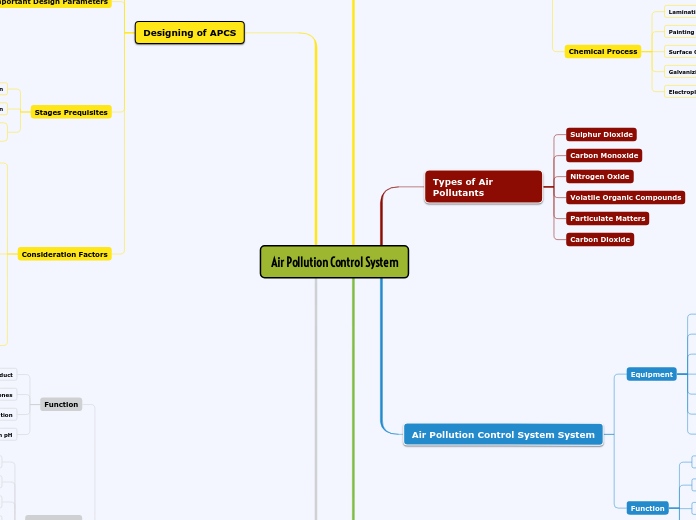Air Pollution Control System
The roots of pollutants
Mechanical Process
Tumbling
Grinding
Conveying
Crushing
Thermal Process
Heating
Drying
Melting
Burning
Chemical Process
Laminating
Painting
Surface Coating
Galvanizing
Electroplating
Types of Air Pollutants
Sulphur Dioxide
Carbon Monoxide
Nitrogen Oxide
Volatile Organic Compounds
Particulate Matters
Carbon Dioxide
Air Pollution Control System System
Equipment
Settling Chamber
Cyclone Dust Collector
Bag Filter Dust Collector
Scrubber
Electrostatic Precipitators
After Burner/Thermal Oxidizer/Flares
Vehicle Spray Painting Booth
Function
Hood-To collect
receives or contain the emitted contaminants
Ducts
To transport air and entrained contaminants within the system
Air Cleaner
To remove contaminants from the air stream
Exhaust Fan
To create airflow in the system and supply required static pressure
Stack
To discharge/dispersed the clean air to the environment
Benefits
Ensure continued performance of air pollution control system
Early indication of impending problem
Lessens possibility of sudden system failure
Avoids unnecessary plant shutdown and costly enforcement
Record keeping requirements help in management review & operating trends
Designing of APCS
Function of APCS
Identify Problem
Develop Plan
Control Source
Verify Source Emission
Verify source compliance
Monitor the air or receive complaint
Principles of APCS
Enclose source as completely as practicable
Capture contaminant with adequate velocity
Transport air & entrained contaminant with adequate velocity
Efficiency of filtering system
Important Design Parameters
Face Velocity (Vf)
Capture Velocity (Vc)
Transport/Duct Velocity (Vd)
Volumetric Flow rate (Q)
Static Pressure (Sp)
Velocity Pressure (Vp)
Total Pressure (Tp)
Stages Prequisites
Adequate Design
Quality Construction
Proper Operation, Preventive Maintenance, Performance Monitoring
Consideration Factors
Environmental Factors
Engineering Factors
Dust Collector
Particle & Air Stream Characteristic
Air to cloth velocity
Collection Efficiency
Pressure Drop
Filter Media
Fan
Fan Pressure
Fan Performance Curve
Economic Factors
Performance Monitoring
Function
Broken/leakage of duct
Corroded cyclones
Bag filters are not working in good condition
Scrubber liquid low/high in pH
Instruments
Smoke Tube
Manometer
Traverse pilot tube connected to manmeter
Surface thermometer
Test hammer
Tachometer
Anometer
Performance to Check
Bag Filter
Pressure Drop
Flowrate
Opacity
Temperature
Dust
Compressed pressure
Scrubber
Temperature
Pressure Drop
Liquid flowrate
pH
